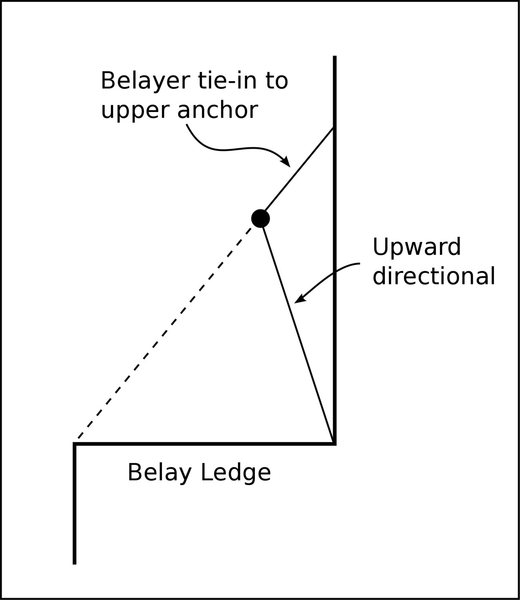upward pull question
|
|
mbk wrote:I imagine that an anchor might experience outward pull when a leader falls past a nice comfy belay ledge. .It would have to be very comfy. To be outward in this context the force needs to be almost horizontal, otherwise the bad angle force is not increased. |
|
|
You do read here and there about the benefit of a piece being able to resist an outward pull. This can happen when the leader is climbing past the piece or in a lead fall. |
|
|
mbk wrote:I imagine that an anchor might experience outward pull when a leader falls past a nice comfy belay ledge. David Coley wrote:It would have to be very comfy. To be outward in this context the force needs to be almost horizontal, otherwise the bad angle force is not increased.Adjust the length of the hold-down anchor strand appropriately and not only is there no "bad angle," there isn't going to be any load on the upward directional at all; all the load will go to the top anchor. The diagram indicates the shortest appropriate upward directional length; longer ones will result in no loading to the upward directional if the falling leader is beyond the edge of the ledge by some amount. If the falling leader somehow manages to fall substantially away from the ledge, then there will be some load to the anchor initially while the leader pendulums around the belayer into the wall below, so there could conceivably be a momentary loading of both anchor strands, with the load to upward directional going to zero as the climbing rope rotates down into contact with the outer edge of the ledge. Eyeballing the vector geometry, I really don't think there is any moment in this process when there could be a momentary exceptional load to the anchor, but I haven't done any calculations reinforce this perception. |
|
|
I'll just add ... |
|
|
bearbreeder wrote: heres what a fall factor 1.5 looks like ...There is no way that was FF1.5. There are several glaring facts in the video that show it's no where near FF1.5, but the most noticeable being that the rope came taught and the belayer started getting pulled up before the weight fell parallel with the belayer, which would be impossible in a fall factor of 1 or higher. I would say that was closer to FF 0.9. Fall factors do not include rope stretch, only the free fall distance of the weight. |
|
|
Bill Lawry wrote:I'll just add ... The large angle in Richard's "Anchor Geometry" sketch could also be an issue when the first protection point on lead is horizontally off to one side or the other of the belay. A long run-out and then fall onto that protection point can result in the significant fall forces pulling the belayer sideways. Once in a while, an upward pull piece should really be a sideways pull piece.This is a very good point---the large angle actually could be a problem in this case. I frequently find myself placing sideways pull pieces on routes that diagonal to the belay stance from the side, either for the leader or the second. And one of the really high fall-factor falls I've held was exactly of this type. The belay was in a sort of alcove-chimney, and the impact plummeted me forward towards the very near opposite wall. Without the sideways directional, I would have smacked that wall hard and face-on with nearly the velocity of the falling leader. By the way, the climb we were on was casual, the fall totally unexpected, and an overhead piece pulled making it into a high fall-factor affair. The next piece was at the level of the belay and horizontally to the side, so the pull was straight horizontal. You never know when your system is going to be severely tested... |

 Continue with onX Maps
Continue with onX Maps Continue with Facebook
Continue with Facebook
























